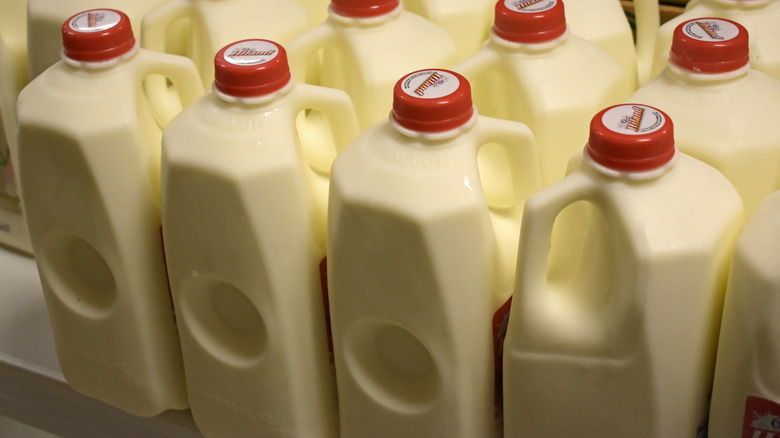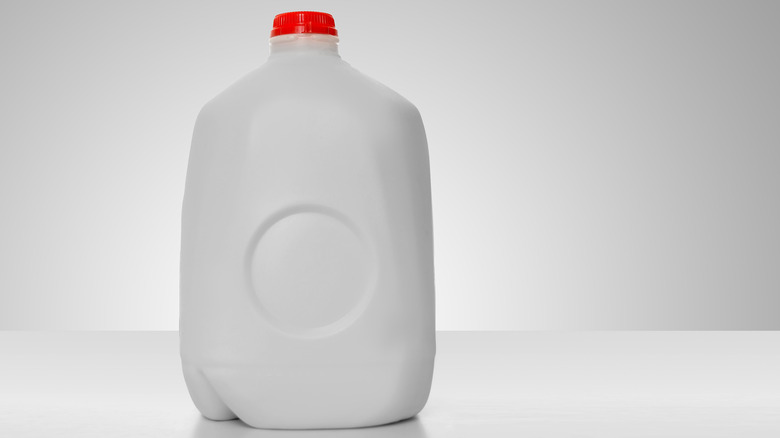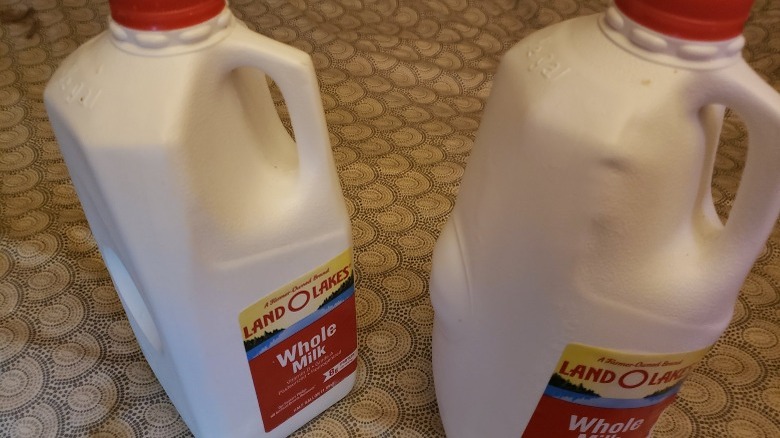The Real Reason Milk Jugs Have Dimples
Milk is one of those grocery store items that have a spot in everybody's kitchen. Even if you've grown fond of adding a dash of oat milk into your morning coffee, we're willing to bet many of you have still got a jug of regular cow's milk on hand to use for any cooking, baking, or cereal eating you may do in the near future. Something else we're willing to bet? That you haven't noticed that circular dimple that's on the side of your plastic milk jug. Seriously, go open up your fridge and check. We'll wait.
Now that you've seen the dimple with your very own eyes (or Googled it, if you live in Canada, where milk typically comes in plastic bags), you're probably a bit curious as to the reason for its existence. As it turns out, that dent is actually a crucial element to the design of a plastic milk jug that serves many purposes, including being key to consistency throughout the year.
Per USA Today, the plastic material that jugs are made of shrinks in warm temperatures. The containers are made slightly larger to account for this, though that also means that in the colder months when there isn't any shrinkage, they may not look as full. Instead of having to completely switch out the base molds each season, manufacturers use interchangeable, dimple-shaped molds so they can easily adjust for the different temperatures while also making sure the milk jugs look consistently full year-round.
Those dimples will also help prevent your milk jug from breaking if dropped
Have you ever tried to bring all of your groceries into the house in a single trip, only to have the milk slip out of your hands and fall to the floor? The world seems to stand still as you watch the jug drop to the ground while the fear of having to clean up an entire gallon of milk overcomes you, but then ... nothing! The jug stays intact, allowing you to pick it up and move on as if the incident never happened at all, and you have the dimple on the side of the container to thank for that.
According to Distractify, this kind of scenario is another purpose for that concave circle on the side of your milk jug, as it gives the plastic container a bit of flexibility that will prevent it from completely cracking in the case of an accidental drop. As one Redditor noted, "the smell of a milk spill that doesn't get thoroughly cleaned up is something to cry over," so this ingenious design certainly shouldn't be taken for granted.
The flexibility of the plastic material will also let you safely store milk in the freezer. Distractify notes that milk will expand when frozen, and will have room to do so thanks to the dimple on the side of the container. Therefore, there's no need to hesitate about stocking up if your grocery store is running a good sale.
Don't believe the myth that the dimple can indicate if your milk has gone bad
There's another theory floating around the internet that claims the indentation on the side of the milk jug can act as an indicator of whether your milk is about to go bad. The story goes that non-harmful bacteria in your milk will release gases over time and allegedly cause the normally concave circle to bulge outwards, meaning it might be time to dump your dairy down the drain (via Distractify).
As helpful as this feature would be for milk drinkers everywhere, it turns out that this is, unfortunately, nothing but a myth that was debunked by the fact-checkers at USA Today. In speaking to the outlet, Penn State professor Bob Roberts explained that there are actually two different types of bacteria in milk, and the gas-producing one isn't always part of the duo. "It (the jug expanding because of bacterial activity) could happen, but most likely if the milk is temperatures-abused, I mean really temperature-abused," Roberts said. "At refrigeration temperatures, you're not going to know your milk is old because the indent pops out." Until there are new updates in milk jug technology, it looks like we'll just have to stick to checking the expiration date before pouring a glass.


